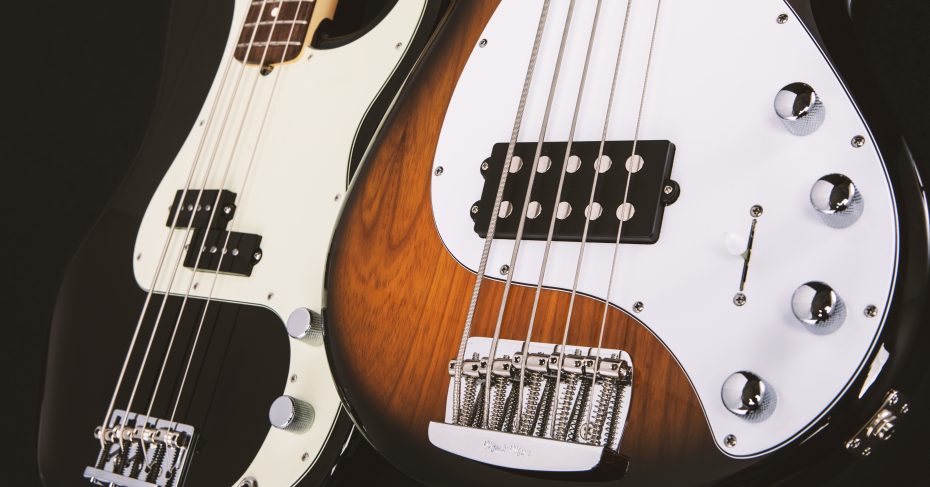
The invention of the electric bass guitar revolutionized the music business. Before that, if you were a bassist, you played an upright. When Fender brought the first production electric bass guitar, the Precision bass, to market in 1951 — and for a couple of decades thereafter — active electronics were not an option. Passive basses were the only choice until the early 1970s when a handful of boutique luthiers, including Alembic, started offering active instruments, which were adopted by bassists such as jazz fusion superstar Stanley Clarke. And back then, you pretty much had to be a superstar (or better still, a superstar with an endorsement deal) to be able to play one of those works of art! Then in the mid ’70s, Leo Fender’s new company Music Man introduced the StingRay bass, a production model with active electronics, forever changing, once again, the landscape for bass players.
Flash forward to today, and Sweetwater offers a dizzying selection of electric bass guitars, both passive and active. If you’re in the market for a new bass (or merely the inquisitive type), you may be wondering what the difference is between active and passive basses. At first glance, the choice may appear to be between modern complexity and time-tested simplicity; but, in reality, there’s quite a bit more to it. They both serve their purposes, depending on what you’re after. So, the real question is: Which one is better for you?
Passive Basses

First off, let’s define, in the context of bass guitars, what is meant by active and passive. Passive basses are simple creatures. They have a pickup (or two) that creates an electrical current that passes through a volume pot and a tone control. Note that this tone control is not an equalizer (EQ); it’s a simple lowpass filter (consisting of a variable resistor that acts on the current when you dial it in), and it does one thing: rolls off highs. It cannot boost frequencies; that would require extra power — in the form of active electronics. We typically describe the sound of a passive bass as being fat, round, earthy, or punchy — perfect for “organic” genres such as rock, blues, jazz, and the like.
Passive: Pros

Passive basses use simpler circuitry than their active counterparts, delivering a sound that’s purer and more touch-sensitive to your playing dynamics. That’s why bass players, engineers, and producers often use terms like “round” or “fat” to describe the sound of a passive bass. The tone controls on a passive bass are also much simpler than those on active basses, with no mini switches or pots inside the control cavity to adjust. You’ll have no ear-splitting highs or booming lows to deal with — only uncomplicated tone and volume controls that are, effectively, out of the circuit when fully clockwise and that cut frequencies or volume when you dial them back. This leaves you with the pure sound of the instrument — the way it was designed to sound with natural, dynamic attack that doesn’t have to push against the compression that’s inherent in many active bass circuits.
Playing a passive bass means not ever having to worry about what can go wrong with onboard active electronics. Granted, any bass can develop problems, but in a simple passive design, there are fewer components, connections, and overall circuitry that can malfunction. There are no pesky batteries that can start to die in the middle of a session or live set, no circuit boards that can loosen, and fewer wires that can become unsoldered. And while you may not have the potent tone-shaping prowess of an active bass, you can always get that from almost any bass amp.
Passive: Cons

There’s no denying the fact that the signal produced by a passive bass is not as strong as that of an active bass. That won’t matter if the pickup on that passive bass is delivering a sufficiently hot signal and you’re keeping your cable lengths to, say, 30 feet or shorter. If, however, the pickup in your passive bass puts out a weak signal, you’re going to have a problem if you use long cables — a problem that only gets worse with every additional foot of cable length. In such a scenario, your signal would not only sound puny, but it could also have noise and RF interference from nearby electrical equipment such as fluorescent lighting. And you will probably crank your amp to compensate for weak output, introducing even more noise from the amp’s circuitry — the perfect storm. Needless to say, gain staging your signal chain in this way is not recommended.
Thankfully, there is a way to ensure you’re getting a quiet, reasonably healthy signal to a distant amp with a passive bass. You could use a long cable run system like the Radial SGI, which has separate transmitter and receiver modules. The transmitter, used at the output of your pedalboard, is essentially a direct box with a 1/4″ input and XLR output that lowers impedance and balances the signal. With this system, you could run the balanced signal through an XLR cable up to 300 feet to the receiver box stationed near your amp. Essentially a “reverse DI,” the receiver takes the balanced XLR input, raises the impedance, and outputs an unbalanced signal your amp will love. You simply use a short 1/4″ instrument cable from the receiver output to your amp.
Active Basses

An active bass is equipped with an internal, battery-powered preamplifier, not unlike the front end of a traditional bass amp. Basses with active electronics do not necessarily have active pickups — in fact, these days, active basses are more likely to be equipped with passive pickups and an active preamp/EQ. These powered circuits usually run on a single 9-volt battery, but lately we’re seeing a trend: instruments that run on 18 volts with compartments for two 9-volt batteries. Doubling the power gives you more of the advantages that active electronics offer over passive, such as higher headroom. Bass players often use terms like “bright,” “snappy,” or “hi-fi” to describe how an active bass sounds, but these descriptors likely stem from the fact that active basses allow you to shape your tone much more than passive basses. It’s due to this inherent tone-shaping ability that we often hear active basses used in more aggressive music like progressive metal, fusion, and (slap-style) funk.
Active: Pros

Thanks to its preamp buffering and higher output signal level, a bass with active electronics is capable of driving long cable runs without the dreaded “tone suck” — signal degradation, noise, and interference — you would get with a passive bass. This provides your amp with a stronger, cleaner signal to work with. If your active bass is sounding a bit too hi-fi, you can always roll back the volume or dial back the highs to achieve a more “passive” sound.
The tone control on passive basses can only attenuate frequencies, but the equalizers on active instruments let you boost frequencies as well for greater tonal flexibility. The preamps in active basses typically offer 2- or 3-band EQ (some even have variable midrange frequency selection), giving you the sound-sculpting capabilities of a bass amp built right into your instrument — convenient for fine-tuning your tone at the source when you’re going direct into a PA system or an audio interface. If you do session work or play in a cover band where you need to hop genres during a session or live set, an active bass will likely serve you well.
Active: Cons

To those opinionated bassists firmly in the passive camp, the hot, consistent signal produced by active basses sounds compressed — in other words, not very dynamic. And we’ve all heard active bass EQ gone wrong in the form of unpleasant hiss from treble frequencies that were boosted too aggressively. A stronger output signal can also wreak havoc with your pedalboard: certain pedals just don’t play nice with active basses. And then, there’s the issue of dealing with batteries.
When the battery in your active bass dies, your sound dies with it — unless your bass can switch between active and passive modes. Swapping out batteries on an active bass with a hinged battery compartment isn’t a huge deal — so long as you have a fresh battery on hand! If you don’t, or if your instrument’s battery compartment door screws on, it’s a major hassle, particularly when you’re onstage in the middle of a set. And for bassists who like to leave their instrument cable plugged in, here’s a word of advice: Get used to buying batteries in bulk, because you will be replacing batteries frequently!
The Best of Both Worlds
So, clearly there are pros and cons on both sides of the active/passive bass debate. But if you want the best of both worlds, you should be playing a bass equipped with an active/passive switch that bypasses the active electronics. When in active mode, you get healthy signal and prodigious tone-shaping abilities; and when switched to passive mode, you get dynamics control and an insurance policy in case your battery decides to die in the middle of your next big gig. If tackling the massive selection of basses in Sweetwater’s Guitar Gallery seems daunting, our Sales Engineers are only too happy to provide expert advice. Many of them are professional gigging bassists, and they will be happy to guide you through the process of selecting the best bass for your needs and budget. Give us a call today at (800) 222-4700, and let’s get started!


